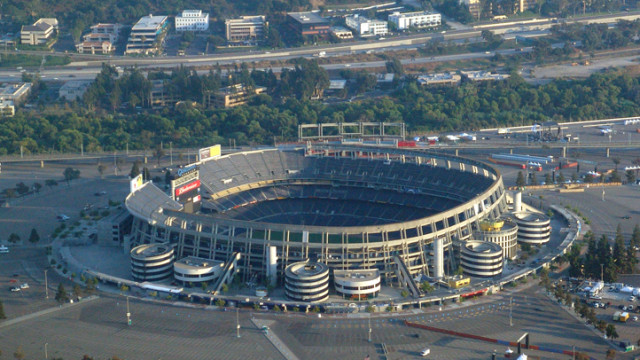A $200 million soccer stadium as part of a $1 billion redevelopment of the Qualcomm Stadium property in Mission Valley was proposed Monday with a citizens ballot initiative drive as the vehicle to bring it about.
The facility containing 20,000 to 30,000 seats and projected to open in 2020 could also be used by San Diego State University’s Aztecs football team and other soccer teams.
The project, coming 10 days after the Chargers relocated to Los Angeles, came from FS Investors, a La Jolla and San Mateo investment group with a variety of present and past ventures, including some sports and commercial developments.
FS Investors, which has the exclusive right to apply for a Major League Soccer franchise, is still working out the details, but in briefings shared with various media outlets and city officials, the company said it proposes to:
Buy the 166-acre site from the city at fair market value, as determined by a third-party. The site has been estimated at about $50 million in its present, unimproved condition;
Demolish 50-year-old Qualcomm Stadium, relieving the city of the annual upkeep of about $12 million and about $100 million in deferred maintenance costs. The city still owes about $28 million on outstanding bonds;
Set aside about 15 acres for an NFL stadium to be built in the next five years if another city’s team wants to relocate and replace the Chargers, assuming the Chargers do not change their minds and want to move back;
Pay for a 55-acre San Diego River Park on the south side of the property;
Cover the costs of offsite traffic improvements associated with the development, as determined in an environmental analysis to accompany the citizens initiative, as well as onsite infrastructure site development costs with details to be laid out in coming weeks; and,
Invite other developers to build housing, including about 800 beds for SDSU students, 10 percent of the remainder for low- and moderate-income renters; office space for SDSU and other tenants, including a possible million-square-foot corporate headquarters; one or more hotels; and related commercial and entertainment uses on the remainder of the property. The overall hope is to develop a transit-oriented development tied to the existing trolley line and one planned along Interstate 15.
Nick Stone, a partner in FS Investors, said the group plans to file an application for an MLS franchise by Jan. 31 and at about the same time begin a signature-gathering campaign to qualify an initiative for a 2018 city ballot. He said FS Investors is aiming for full control of the site to make sure the new stadium is surrounded by appropriate development that he said could serve as a sports and entertainment district.
The city clerk’s office said only 21,494 signatures from registered voters would be needed if FS Investors simply want to ask the City Council to consider their proposal. But if sponsors want to force council action, they would have to collect 71,646 signatures. The council would have to either adopt the proposal or put it on the November 2018 ballot, if not sooner.
However, the group hopes to convince the City Council to approve the measure outright rather than send it to the voters. To wait until 2018 would probably kill the chance to gain MLS approval this year and for the foreseeable future, he said. The 24-team league is seeking four more teams to round out its membership this year and no further expansion is contemplated. It will cost new franchise holders $150 million to land a team in a new city.
“We think San Diego is an amazing soccer market,” Stone said, noting the region toted up the second highest viewership, after Washington, D.C., of the World Cup in 2014. “We just think the logic of soccer in San Diego is incredibly compelling.”
Initial reaction to the proposal has been generally positive.
A poll of 700 adults conducted for The San Diego Union-Tribune and KGTV-10 News by SurveyUSA showed that 70 percent support the soccer proposal with men, young people and Hispanics the most in favor. There was a 3.5 percent margin of error. Even more, 74 percent, support development around the stadium, with a 3.3 percent margin of error.
«This is an exciting concept that could welcome major league soccer to San Diego without public subsidy, provide a home for Aztecs football and create a long-awaited river park,” Mayor Kevin Faulconer said in a statement issued by his office. “I look forward to seeing the final plan.»
Councilman Scott Sherman, whose district includes the Qualcomm site, said the MLS plan improves on the Chargers’ downtown proposal because it doesn’t require a tax increase or taxpayer support.
“These guys been have been willing to work with us,” Sherman said. “They have been to the council and mayor’s office several times and we’ve seen soccer representatives a lot more than than we’ve ever seen from the Chargers.”
As to whether more public input or a public vote should take place, Sherman said he still wants to get the details before making a commitment. But he agreed with the sponsors that time is of the essence.
Faulconer previously promised to put a new stadium on the ballot, but FS Investors believes the commitment was tied to any tax increase or public spending requirement, which the company does not contemplate. The Chargers launched a similar initiative drive last year to build a new football stadium and convention center annex downtown, but it included a hotel room tax increase and appeared on the Nov. 8 ballot as Measure C, which was defeated.
A separate measure, Measure D, laid out development criteria for the Qualcomm Stadium site and included a smaller hotel tax increase, but it, too, was defeated. However, Stone said several aspects in Measure D, particularly the park, have been included in the soccer plan to please environmentalists.
Meanwhile, the Gensler architectural firm is preparing site plans and architectural renderings for the new proposal with a major announcement possibly coming after Sunday’s U.S. men’s national soccer team match against Serbia at Qualcomm. One rendering was released Monday that shows what the new stadium might look like on the interior. Other details expected about the same time would include the number of dwelling units, amount of commercial development and parking spaces.
The value of the completed development has not been released but FS Investors project it at $1 billion or more — enough to generate about $10 million annually in local property taxes that would have to be shared with school districts and the county, plus sales and hotel taxes. The stadium itself is estimated at $200 million.
“Part of the reason why we think this creates a ‘win’ for the city,” Stone said, “is because we are not only delivering the river park but we are relieving the city of the maintenance of Qualcomm, committing to condemnation (of the stadium) and creating a massive tax base.”
Stone said discussions are ongoing with SDSU on how it might participate in a joint-venture for the soccer stadium. The campus has already spoken of raising $100 million as its share. FS Investors pledges to eventually donate its 50 percent share to the university.
Megan Collins, chief of staff to SDSU President Elliot Hirshman, said FS Investors and the university have been discussing the soccer-Aztecs stadium over the past several months.
“We have been so pleased by the outpouring of community support that we have received around these discussions,” she said. “There’s still work to be done.”
Athletic Director J.D. Wicker said the campus wants to know what revenue streams might be attached to the stadium, such as from corporate skybox suites, advertising, parking and concessions. If the soccer stadium partnership falls through, he said SDSU hopes to extend its lease at Qualcomm for four more years and then look for other parties that could be involved.
FS Investors has held present and past stakes in a wide variety of businesses, including the Sacramento Kings professional basketball team and a variety of mixed-use developments. It is headed by Michael R. Stone (unrelated to Nick Stone), who besides various business ventures has been active in a number of charities and institutions locally and nationally, from the San Diego Museum of Art to the Library of Congress. The company maintains offices in La Jolla and San Mateo and expressed interest in bringing professional soccer to San Diego last summer.
Other principals and investors include Steve Altman, former president of Qualcomm Corp.; brothers Masood and Massih Tayebi, active in telecommunications companies; and Peter Seidler, largest shareholder of the San Diego Padres. Serving in an advisory role is Mark Schlossberg, founder and managing partner of the locally based Southwest Value Partners real estate investment firm.





